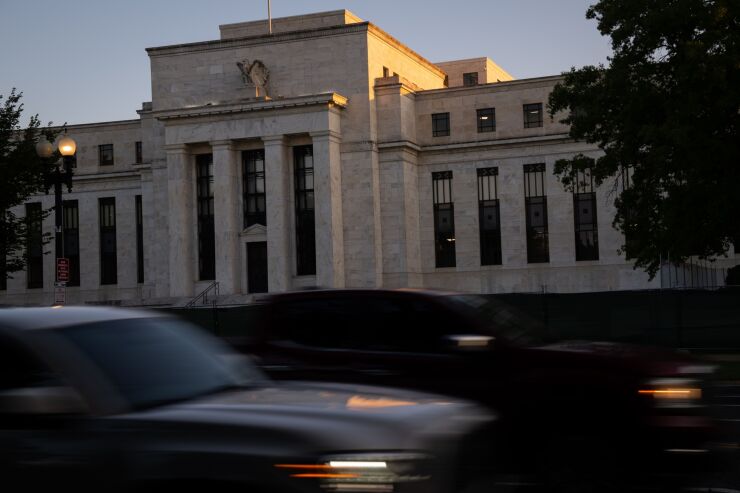Congress will do nothing about anything until the midterm election seals each member's fate. Thus, I expect nothing to come from Congress in 2022 responding to the Federal Reserve's sudden turn for the financial worst.
However, when Congress again comes to thinking about the Fed, it will not go unnoticed, despite all the acrimony about monetary-policy miscues, that taxpayers are in some ways now far more clearly subsidizing payments to banks, money market funds and other financial companies holding deposits with the central bank or using its standing market windows.

The last time Congress thought about interest rates on reserves (IRR), more than a few members wanted it back. Given that these payments are now at what seems direct taxpayer cost, they'll have a lot of new friends in the next Congress unless someone quickly shows why these interest payments are an artifact of Fed confusion, not big-bank malfeasance.
Yes, I know — the $2.9 billion loss the Fed reported in terms of Treasury remittances for the first week of October isn't a direct taxpayer subsidy any more than the hundreds of billions the Fed has sent to the Treasury since 2008 are funds directly taken from taxpayers. The ups and downs of Fed remittances are the result of balance-sheet operations consisting of liabilities owed to financial companies and earnings on assets in the Fed's portfolio. Neither is direct spending nor revenue raising.
This is, though, a technicality for members of Congress who have become used to having the Fed — and for that matter, Fannie Mae and Freddie Mac — readily at hand to smooth over what would otherwise be considerable awkwardness in reckoning with just how big the federal deficit actually is.
The Fed shortfall cited above is a hard-dollar drop in Fed remittances to Treasury versus $170.4 billion in FY21. It doesn't reflect the Fed's mark-to-market unrealized loss on its huge portfolio of Treasury and agency mortgage-backed securities, estimated by Bill Nelson at the Bank Policy Institute as $458 billion.
These losses are material and then some, but — unlike direct losses due to the difference between earnings on assets and the cost of liabilities — they don't count for much of anything fiscal unless or until the Fed is forced to sell assets or recognize that it will never have earnings sufficient to absorb the reckoning it may now defer. As long as the Fed can hold this fictional financial fort — and that's likely a very, very long time — only its remittance shortfalls matter to a Congress forced to make them up with new revenue sources and its mark-to-market losses matter only to a green eyeshade or two in terms of actual bottom-line impact.
This is not only because Congress has to come up with new money if prior deficit assumptions counted on Fed remittances, as indeed they did. What matters even more is that the Fed will be seen to be sending big money to big financial companies not out of so abundant a payment to Treasury that it didn't much matter, but now as a deficit to taxpayers someone else has to make up.
Even when IRR was paid out of remittances with loads of room to spare, members of Congress from both parties so strongly resented these payments that we were asked to write a paper on why interest was paid on what were then called excess reserves.
In that paper, we successfully showed that banks weren't exploiting the Fed by earning an easy buck on IRR rather than investing deposits in the loans essential for economic growth. Much of what we said then is true now, but the overnight reverse repo program (ON RRP) complicates an analysis of the equity and subsidy value of Fed interest payments to mostly giant financial-services companies.
The reason here is that this window is not a longstanding artifact of Fed operations like IRR — controversial as that still was. Instead, these are standing facilities of $2 trillion or even more that exist for two politically hot-button purposes.
First, this window makes it easier and cheaper for giant financial companies to handle liquidity strains on a day-to-day business basis. This is the Fed's new market-maker-of-first-resort role far, far afield from its statutory lender-of-last-resort function and even from a role as market-maker of last resort that's come to be generally accepted despite the sharp hike in moral hazard rightly noted in another recent BPI paper.
Second, the Fed's ability to set monetary policy is laid bare by the fact that it must now rely on payments to big financial companies to keep U.S. interest rates within desired ranges. Like IRR, the ON RRP is a tool the Fed uses to conduct monetary policy because none of its other tools is working as hoped. The combination of quantitative easing without any plan other than the quantitative tightening now roiling financial markets even with all the Fed's enormous liquidity backstops shows that the Fed knows of no way out of its monetary-policy dilemma other than becoming not just the central bank it's supposed to be, but also the superbank it's become.
Although the Fed's balance sheet has become a quagmire, its financial impact on the federal deficit is crystal clear. When the Fed made money for the Treasury, Congress was content largely to look the other way. Now that its infallibility is badly dented, the Fed is uniquely exposed not just to monetary-policy griping, but also to becoming a tool to advantage fiscal policy. This puts its independence at risk, but so have all the other decisions it has made in recent years to expand not just its mandate, but also its financial-market control.
Editor's note: This article originally appeared in an email to Federal Financial Analytics' clients.






